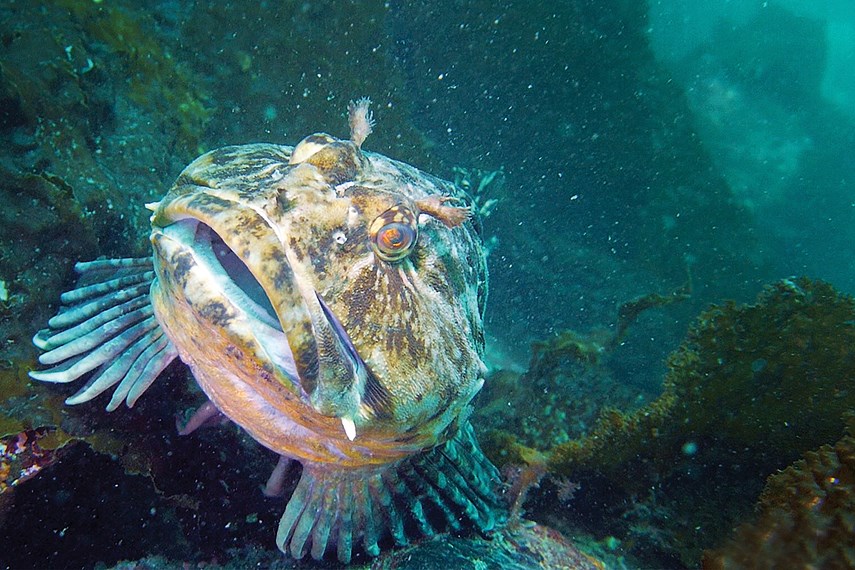This Living Salish Sea, North Shore Unitarian Church (370 Mathers Ave., West Vancouver), Dec. 6, 7 p.m. Filmmaker in attendance with Q&A after screening. Fundraiser for Northern Lights Wildlife Sanctuary. Suggested donation $10. For more information visit livingsalishsea.ca.
When the house is on fire, why not take to the ocean?
That’s partly the message behind filmmaker, documentarian and scuba diving enthusiast Sarama’s new film, This Living Salish Sea.
“Basically, the house is on fire,” he tells the North Shore News. “Some people are wanting to pour gas on it and other people want to put the fire out. That’s where we’re at. We’re at a critical junction in human history.”
The “house” he refers to is the natural world, and the fire is caused by the destruction that humans have wrought. But Sarama (the filmmaker only goes by one name) hopes that exposing people to the wonders of the sea can instill a sense of importance in maintaining the underwater world, and by extension the world itself.
“I realized that for the vast majority of people when they look at the water they see a reflection, basically it’s like a two-dimensional surface, and that’s what they see,” he says.
“People have a vague understanding of what’s under there but not too specific. They don’t really know. And I thought it was absolutely critical for the public to really understand this debate that they understood the treasure that we have here.”
Sarama, 64, knows that treasure well.
He has been involved in social justice activism for decades, in large part dealing with climate change issues, and has had a deep connection with the Salish Sea his whole life.
This Living Salish Sea, a 95-minute documentary that’s Sarama’s biggest project to date, appears to fuse several types of storytelling together.
In one part, the film is like a memoir tracing Sarama’s childhood and affinity for natural bodies of water; in another part it follows a dramatic narrative where scientists, activists and politicians are interviewed regarding multi-billion dollar corporations, pipeline projects and oil tankers, and the toll these projects could ultimately have on the environment.
Perhaps most importantly, the film ventures at times into simply documenting nature. Sarama captured more than 300 hours of footage for the project, including substantial underwater footage that shows the majestic Salish Sea in order to get his point across.
He recalls first receiving a diving mask and snorkel at age eight and the impact this had on him. “The moment you have that faceplate on … all of sudden you have this entry into another dimension. And, of course, for me it was totally magical,” he says. “From my very, very first memories I always had this passion, this obsession, with this underwater world.”
When he was 16, he got into scuba diving and never looked back. At 17, he started filming underwater and as camera technology improved his forays into filmmaking became more serious.
This Living Salish Seawas more than four years in the making but the impetus for the project came about in 2012 while he was working on a short film that dealt primarily with an issue related to Gibsons, B.C., where he has lived for the past 20 years.
“I was spending a lot of time underwater at this location shooting extensively and I was thinking at the time of the Kinder Morgan issue because it was coming over the horizon,” he explains. “I was absolutely horrified at this prospect that they would be doing this major expansion and the threat that it implied to the Salish Sea.”
Sarama went into his Salish Sea documentary with two main concerns: the local impacts from potential oil spills from pipelines and tankers, and the overall damage wrought by global climate change.
He realized, he says, that with the conversations that emerged in the wake of increased tanker traffic and Kinder Morgan’s proposed Trans Mountain pipeline there was precious little talk about what actually lay below the ocean surface.
“I wanted that to be part of the awareness when people were discussing things, so that’s why I spent so much time documenting what was in the sea, how it worked, and tried to lay that out in laymen’s terms,” he says.
Everything from octopus, rare glass sponge reefs and rockfish – all off the B.C. coast – are captured with attention and care that reveals Sarama’s love of underwater nature.
Besides the extensive underwater footage, Sarama captured numerous scenes from the Burnaby Mountain protests in 2014 that netted many arrests after protesters and activists were targeted for violating a court-ordered injunction protesting a pipeline expansion. He spent nine days on the mountain filming the protests, he says.
“The commitment by a great variety of the community from all backgrounds – grandmothers, children, different ethnic and racial backgrounds, First Nations people, people from many different backgrounds – there was the entire community represented there,” he says.
The self-funded documentary may toe the line between a gloomy outlook and a fiery positive one, but Sarama admits he has seen things change during the almost five years he spent making the film.
“There’s been a big shift in the number of people who are aware and concerned about climate change, and I think one of the reasons that has happened is because of the tragedy of different world events that have occurred,” he says, referring to last summer’s record-setting experience with wildfires in B.C.
Is there hope for the future, the environment, for the Salish Sea? Samara admits humans are capable of “astonishing things.” He just hopes his film can help showcase what’s at stake.
“I would say, if there’s any hope, it’s this capacity for humans to adapt and change and make those choices that we need to know,” he says. “The question is this: Do people know that we are faced with that type of critical emergency?”



